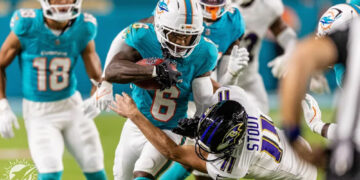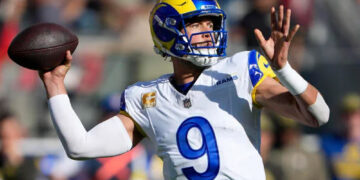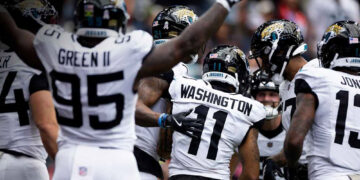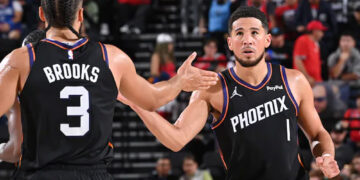The game between the Minnesota Vikings and Chicago Bears on September 8, 2025, was full of surprises. It was a classic NFC North battle — tough, loud, and down to the wire. While the final score shows the Vikings won 27–24, the real story is told through the player stats.
These numbers show who made big plays, who made mistakes, and how the game shifted in just a few minutes. If you want to know why the Vikings won and how the Bears lost control, this breakdown of the Minnesota Vikings vs Chicago Bears match player stats will help you see everything clearly.
Let’s go step by step and look at all the key parts of the game — from quarterback battles to game-changing moments.
Quarterback Stats from the Vikings vs Bears Game
Quarterbacks often decide how a game goes, and this one was no different. Both QBs had exciting moments, but one showed more calm and control when it really mattered.
J.J. McCarthy, making his NFL debut for the Vikings, started slow. But in the fourth quarter, he came alive. He threw 2 touchdown passes and ran for another score, all in the final 10 minutes. He finished with 143 passing yards and added 25 rushing yards too. Even though he threw an interception earlier, he didn’t panic. He bounced back and led the team to win.
On the other side, Caleb Williams had a great start for the Bears. He completed his first 10 passes and looked sharp. He ended the night with 210 passing yards, 1 passing TD, and 58 rushing yards with 1 rushing TD. But as the pressure built, he started to struggle. In the second half, he missed more throws and couldn’t keep up with the Vikings’ comeback.
The stats show that McCarthy stayed calm and clutch, while Williams started hot but faded late in the game.
Big Moments That Changed the Game
Some games change in just a few plays — and that’s what happened here. The Minnesota Vikings vs Chicago Bears match player stats clearly show how fast the game turned.
The Bears were winning 17–6 in the third quarter after a 74-yard pick-six by Nahshon Wright. Things looked great for Chicago at that moment. But then it flipped. Cairo Santos, the Bears kicker, missed a 50-yard field goal early in the fourth quarter. That miss gave the Vikings good field position — and they took full advantage.
In just a few minutes, McCarthy threw a 13-yard TD to Justin Jefferson, then followed it with a 27-yard TD pass to Aaron Jones, and finally ran one in himself. Just like that, the Vikings were up 27–17.
The Bears did score once more, but it was too late. Those three quick scores from the Vikings changed everything.
Full Rushing Stats for Bears and Vikings
Running the ball is always important, especially in close games. Both teams had moments where the ground game worked — but one side used it better when it counted most.
For the Vikings, Jordan Mason was the top rusher. He had 68 yards on 15 carries, with a strong average of 4.5 yards per run. He didn’t score, but he helped keep the drives alive during the fourth quarter comeback. He ran hard and broke tackles — doing the dirty work.
J.J. McCarthy also added 25 rushing yards on just two plays, one of which was a 14-yard touchdown run that sealed the win.
The Bears had more speed in their rushing. Caleb Williams ran for 58 yards, including a great 9-yard touchdown in the first quarter. D’Andre Swift had 53 yards on 17 carries, but his average was lower at 3.1 yards per carry. He struggled to gain yards in key moments, especially in the fourth quarter.
The stats show that Minnesota’s running backs wore down the defense late, while Chicago couldn’t run the ball when it mattered most.
Receiving Leaders from the Match
Great catches and long plays always get fans excited — and this game had a few. Let’s take a look at the top performers from both teams based on the Minnesota Vikings vs Chicago Bears match player stats.
For the Bears, DJ Moore led the way with 3 catches for 68 yards. He had one big play for 30 yards and broke a tackle, showing his power. But sadly, he also fumbled on the final play, which ended Chicago’s last chance to come back.
Rome Odunze, the rookie, was targeted the most — 9 times. He caught 6 passes for 37 yards, including a 1-yard TD late in the game. He played with confidence and showed good hands.
For the Vikings, Justin Jefferson caught 4 passes for 44 yards, including a 13-yard touchdown that started the fourth quarter comeback. He didn’t have many catches, but the one that counted most was his.
Aaron Jones also helped with 3 catches for 44 yards, including the game-winning 27-yard TD.
These receiving stats show that Minnesota’s receivers made the big plays in the big moments, while Chicago’s receivers had good numbers but couldn’t change the game outcome.
Red Zone Stats: Who Finished Better?
The red zone — the area inside the opponent’s 20-yard line — is where many games are won or lost. And in this one, red zone performance made a big difference.
According to the Minnesota Vikings vs Chicago Bears match player stats, both teams reached the red zone and scored, but timing and execution made the difference.
Minnesota had 3 red zone trips and scored 2 touchdowns and 1 field goal — that’s 100% scoring success. Most importantly, their red zone touchdowns came in the fourth quarter when the game was on the line.
Chicago also went 2-for-2 in the red zone, but both touchdowns came at less important times. One was early, and the other was too late to change the final score.
The numbers show that Minnesota’s red zone scores helped win the game, while Chicago’s came too early or too late to matter much.
Third Down Stats: Key to Control
Third downs decide if drives stay alive or end. Good third-down stats usually mean a team controlled the game — and the Minnesota Vikings vs Chicago Bears match player stats highlight that perfectly.
In the first three quarters, Minnesota was 0-for-8 on third downs. They couldn’t keep drives going, and it showed in the score. But in the fourth quarter, they flipped the script — 3-for-4 on third downs. That sudden improvement helped them move down the field and score quickly.
Chicago, on the other hand, started better but finished cold. They went 0-for-3 on third downs in the final quarter. That means they couldn’t keep drives alive when they needed to most.
This stat tells the story of the game. Minnesota stepped up when it mattered, and Chicago couldn’t respond.
Turnovers in the Vikings vs Bears Match
Turnovers can change a game in just one play — and that’s exactly what happened here. When we look at the Minnesota Vikings vs Chicago Bears match player stats, turnovers played a huge role in how things ended.
The Bears had the biggest turnover of the game — a 74-yard interception return by Nahshon Wright. That gave Chicago an 11-point lead in the third quarter. But after that, things went downhill.
Justin Fields had two turnovers — one interception and one fumble. That hurt the Bears badly, especially when they were trying to keep the lead. They also muffed a punt, giving the Vikings even better field position.
The Vikings had just one turnover, and they didn’t let it slow them down. They quickly got back on track. The final turnover count was 3 for Chicago and 1 for Minnesota — and that gave the Vikings more chances to win.
Defense Standouts from Both Teams
Defense is more than just tackling. Good defenses make big plays, stop third downs, and create turnovers. The Minnesota Vikings vs Chicago Bears match player stats show us which players made the biggest difference.
For the Bears, Tremaine Edmunds had 10 tackles and even grabbed an interception. Montez Sweat added a sack and kept pressure on McCarthy. These players worked hard to keep Chicago ahead for most of the game.
But in the fourth quarter, the Vikings’ defense stepped up. Danielle Hunter had 2 sacks and was all over the field. Javon Hargrave also had a strong debut with 2 sacks of his own. And Eric Wilson, a veteran, came in after an injury and made a key blocked punt that helped change momentum.
While both teams had good defenders, the Vikings made more big plays when it mattered, especially in the final 15 minutes.
Special Teams Stats from the Game
Special teams are easy to forget, but they often decide field position — or even the final score. In the Minnesota Vikings vs Chicago Bears match player stats, special teams made a big difference.
Will Reichard, the Vikings’ kicker, was perfect. He made both his field goals, including a huge 59-yarder before halftime. That tied a record and gave Minnesota much-needed points.
Cairo Santos, the Bears kicker, hit his short kicks, but missed a 50-yard field goal at the start of the fourth quarter. That miss gave the Vikings a short field — and they quickly scored. That one miss might have cost Chicago the game.
In the return game, Myles Price helped the Vikings with great punt returns, averaging 17 yards. That gave McCarthy and the offense a better chance to score.
These small things don’t always show up in highlights — but they helped shape the final score.
Coaching Decisions Seen in the Stats
A good game plan can lead to a win. A bad decision can lead to a loss. And sometimes, coaching shows up clearly in the stats — just like in this game.
Ben Johnson, the Bears’ new coach, played it safe early but took a risk on 4th-and-3 in the second quarter. They failed to convert and missed a chance at an easy field goal. Later, penalties and timing issues made things harder.
Kevin O’Connell, the Vikings’ coach, made smart changes at halftime. He asked his defense to blitz more, which caused problems for Williams. He also used a smart running back rotation — Jordan Mason ran hard early, and Aaron Jones came in fresh to catch the winning touchdown.
In the end, O’Connell’s decisions helped the Vikings stay calm, adjust, and win, while Johnson’s choices didn’t work out when it counted.
Full Team Stats Breakdown
Sometimes it helps to see the full game in numbers. Here’s a clean summary of the Minnesota Vikings vs Chicago Bears match player stats:
| Category | Vikings | Bears |
|---|---|---|
| First Downs | 14 | 20 |
| Total Yards | 254 | 317 |
| Passing Yards | 134 | 198 |
| Rushing Yards | 120 | 119 |
| Turnovers | 1 | 3 |
| Penalties (Yards) | 8 for 50 | 12 for 127 |
| Time of Possession | 27:07 | 32:53 |
| Third Downs | 3/12 | 3/12 |
| Red Zone Success | 2/3 | 2/2 |
The Bears had more yards and more time of possession, but the Vikings were more efficient and made fewer mistakes. That made all the difference.
Advanced Stats and Final Takeaways
Let’s look at a few advanced stats that explain what happened behind the scenes:
-
Vikings scored more points per minute than the Bears — showing they used time better.
-
Expected Points Added (EPA) shows Vikings were better on special teams and offense in the fourth quarter.
-
Success Rate was slightly higher for the Bears, but the Vikings had more explosive plays when it mattered most.
So what’s the final takeaway?
The Minnesota Vikings vs Chicago Bears match player stats show how close the game was — but also how quickly it turned. The Bears led most of the game, but small mistakes, missed kicks, and penalties opened the door for the Vikings.
McCarthy’s debut will be remembered for his cool under pressure. The Bears showed talent, but not enough control. If Chicago cleans up their penalties and improves late-game choices, they can bounce back. But this night belonged to Minnesota.
Conclusion
Stats tell more than just numbers — they tell the real story of the game. The Minnesota Vikings vs Chicago Bears match player stats help us understand how the Vikings pulled off a shocking win, and where the Bears fell short.
It wasn’t just about one player — it was about timing, pressure, and smart decisions.
Now the question is: Can the Vikings keep this momentum going? And will the Bears learn from their mistakes?
Let’s wait for next week, because in football, anything can happen.
You may also read: New Orleans Saints vs Kansas City Chiefs Match Player Stats













